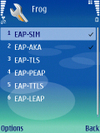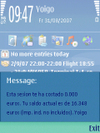There is currently a lot of hype around Femtocells, tiny user installable 3G cells for homes and offices. Surely an interesting technical concept but still with many question marks attached such as why would users want a 3G cell at home or at the office and what the benefits are for the operator. Here’s what I think:
Operator Benefits
3G networks are operated on the 2100 MHz frequency band in Europe and Asia and in the 1900 MHz band in the U.S. which is far from ideal for in-house coverage. Even in cities it can be observed that dual mode 2G/3G mobiles frequently attach to the 2G network because many GSM operators use the 900 MHz band in Europe which is much better suited for in-house coverage as lower frequencies penetrate walls much better. Some proponents of Femtocells claim that in-house coverage for voice calls are greatly improved by Femtocells. In cities however, this benefit is rather small since GSM in-house coverage is usually not an issue. The user on the other hand does not really care if his voice call is handled by the 2G or 3G network.
An improvement could be seen however in cases where the mobile can’t decide to stick with either the 2G or the 3G network due to changing 3G signal levels. This creates small availability outages while the mobile selects the other network type. During these times, incoming voice calls are either rejected or forwarded to voicemail.
Also, it can often be observed in practice that a mobile device with weak 3G in-house coverage changes to the 2G network once a connection to the Internet is established (e.g. to retrieve eMails or to browse the web on the mobile phone) and sometimes changes back to the 3G network during the connection. The reason for these ping pong network selections are the changing reception levels due to the mobility of the user and changing environmental conditions. Such network changes result in outage times which the user notices since an eMail takes longer to be delivered or because it takes a long time for a web page to be loaded.
Another solution to the issues described above is the use of the 900 MHz frequency band for 3G in Europe and Asia and the 850 MHz band in the U.S. It is likely that this will happen over the next few years since regulators more and more tend to open the 900 MHz band for 3G networks in Europe. It will take a number of years however before network operators will have deployed their 3G networks in those lower frequency ranges and until devices for these bands are available. It’s also likely that 900 MHz cells would first be used to cover rural areas instead of enhancing coverage in areas already covered by 3G in the 2100 MHz band. In the meantime, Femtocells definitely have the advantage.
As the above weaknesses of 3G in higher frequency bands show, femtocells can increase customer satisfaction. Putting a femtocell in the user’s home would have the additional advantage for network operators of reducing churn, i.e. customers changing contracts and changing the network operator in the process. Customer retention is all the more reinforced if the Femto comes in a bundle with DSL access as further described below since changing wireless contracts also has consequences for the fixed line Internet access at home.
Another advantage of femtocells is to reduce the gradual load increase on the 3G macro network as more people start using 3G terminals for voice and data connections. This could result in a cost benefit since if the right balance of macro and femtocells are reached, fewer expensive macro cells would be necessary to handle overall network traffic.
The question is how much these advantages are worth to a network operator since Femtocells do not come for free!?
More to come
So much for now. Part 2 to come soon deals with why users would put a 3G femotcells into their home and part 3 will look at the technical background and hurdles for femtocells.
As always, comments are welcome!



